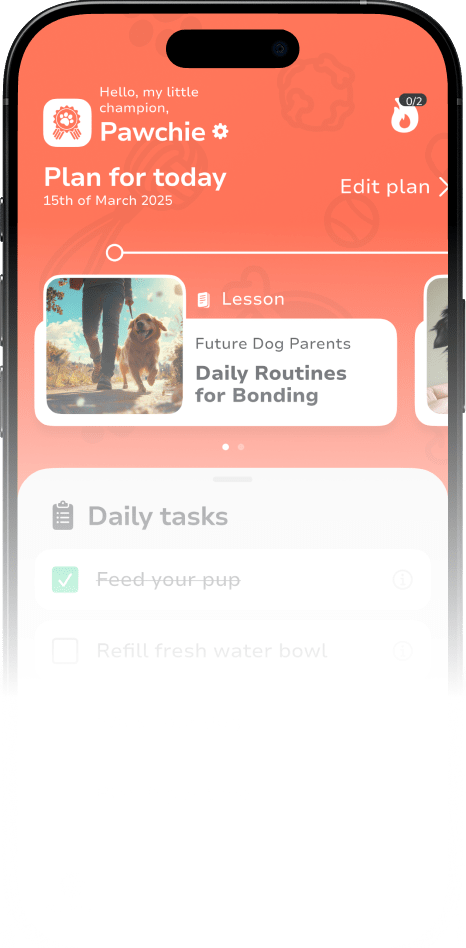Leash training your dog might sound simple – until you're being dragged down the block like a human sled. This is the perfect place to start if you have an inquisitive puppy or are attempting to retrain a dog that believes that tugging is a part of the game.
At PawChamp, we believe in gentle, effective methods that make walking with your dog enjoyable for both of you. With the proper guidance and a little consistency, dog leash training becomes more than manageable. It becomes rewarding.
What this PawChamp puppy walking guide covers:
How to start puppy leash training on the right foot
Why your dog pulls and how to change that behavior
The most helpful leash training techniques you can apply today
How to read your dog's signals during walks
The role of tools like a no-pull dog leash
What to do when walks go south
How the PawChamp leash training methods can help you succeed
Why Leash Training Matters
Walking together isn't just a way to burn energy—it's one of the most powerful bonding activities you can share with your dog. But only if you're both on the same page.
Walking Multiple Dogs on Leashes
A dog walker manages multiple dogs on leashes during an outdoor walk. PawChamp helps dog parents build leash control and enjoy calmer, safer walks with training tips that work.
Most dog leash behavior issues stem from misunderstanding. You expect a calm stroll. Your furry friend sees a world full of distractions and wants to chase every sound and smell.
Most dogs aren't pulling to be "alpha"—they're just excited, curious, or unsure. The truth? They do not come pre-trained to walk on a lead. It's up to us to guide them with clear expectations and kindness. Think communication, not domination. When done well, leash training for dogs teaches patience, builds confidence, and creates a routine your pooch can rely on.
Leash Training = Safety for All
And there's a safety reason to train, too. According to a study published in The American Journal of Emergency Medicine, an estimated 356,746 adults were treated in U.S. ERs for dog leash-related injuries between 2001 and 2018.
The most common causes? Being pulled, tripped, or tangled in the leash. Injuries included fractures, sprains, and head trauma—most often affecting women, and especially those in midlife and older.
So yes, good dog walking training isn't just for the dog's sake in avoiding bad habits. It protects your body, your confidence, and your time at the doctor's office.
Puppy Leash Training Basics
Dog Practicing Leash Training
A poodle practices calm leash behavior with its owner during a training session. PawChamp provides step-by-step leash training methods to build focus, patience, and confidence in dogs.
You can begin puppy leash training as early as 8 weeks old. At this stage, it's not about perfection—it's about comfort. Let your pup wear their harness and lead inside the house first. Let them explore. Don't rush it. You're not teaching "heel" yet—just helping your puppy get used to the leash and harness.
How to Make It Positive
Let your puppy drag the lead around for a few minutes
Pair it with treats, praise, and gentle play
Practice a few guided steps at a time
Don't pull if they freeze—build confidence slowly
The PawChamp puppy walking guide can help your pup build confidence before they ever hit the sidewalk.
Fun fact:
Dogs have over 300 million scent receptors in their noses. That's why a short walk with your dog can feel like a sensory explosion—for them, every lamppost tells a story.
Dog Leash Signals to Watch For
Excellent lead communication starts before the leash tightens. Dogs rarely pull without warning—they show subtle shifts in body language that give you a chance to redirect their attention early.
Look for these familiar pre-pull cues:
A sudden forward lean, especially with weight shifting to the front paws
Ears pointing or twitching toward a trigger (like a bird, pup, or skateboard)
Tail movement that changes quickly—freezing, lifting, or wagging stiffly
Breathing changes or an alert stance with a stiff body
Eyes locking intensely on something ahead
These signs are your cue to act. Try calmly saying "let's go" while changing direction, or offer a treat to draw their eyes back to you before tension builds.
This kind of awareness is especially helpful when working on puppy leash control or managing overexcited adult dogs. If leash reactivity is an issue, PawChamp leash training tips break down how to read your dog's signals and respond effectively based on their age, temperament, and learning stage.
Leash Training Techniques You'll Actually Use
Let's cut through the noise. Here's a simple way to think about how to leash train a dog:
Start calm: Don't leash up while your dog is bouncing off the walls. Wait for calm behavior before you clip the leash on.
Begin indoors or in a quiet yard: Especially for puppies or reactive dogs, too much stimulation ruins focus.
Use high-value rewards: Treats, praise, even toys—whatever makes your dog say "yes, please."
Mark and reward good leash behavior: Reward every time your dog walks next to you with a loose leash, especially early on.
Stop pulling: No drama, no yelling. Just stop moving.
This is how you build dog leash control from a place of understanding and trust—not fear or frustration.
Tools That Help (But Don't Replace Training)
A no-pull dog leash or harness can definitely help—especially if your dog is strong or has built up a big pulling habit. Just remember:
No-pull tools reduce pulling but don't teach polite walking
Use them as training aids, not permanent solutions
Combine with clear leash training techniques and rewards
The PawChamp leash training guide includes product suggestions that align with your dog's walking style—so you're not stuck guessing what might help.
Dog Lunging on Leash During Walk
A dog lunges on leash during a walk, showing common pulling behavior. PawChamp leash training methods teach dog parents how to manage reactivity, improve focus, and enjoy calmer, safer walks.
Bottom Line
Leash training takes time, repetition, and a willingness to adapt. But it works. More importantly, it builds trust. Focus on shaping habits, not chasing perfection. Keep your sessions short, your tone upbeat, and your expectations clear. This isn't a race—it's a relationship. With the right tools, timing, and encouragement—plus a little help from the PawChamp—your furry companion will learn to walk by your side calmly. You'll both look forward to every walk. And that's the real win.

